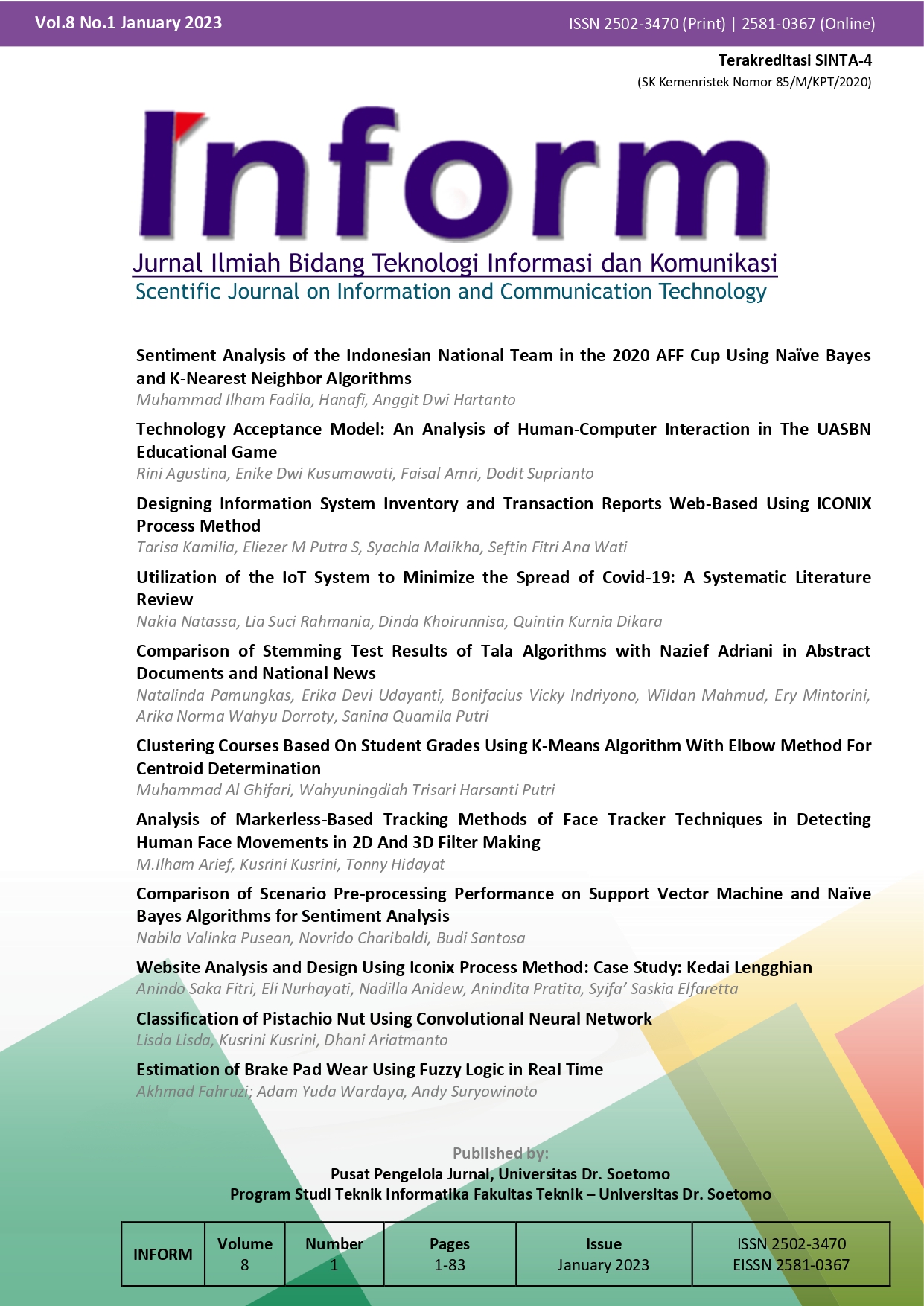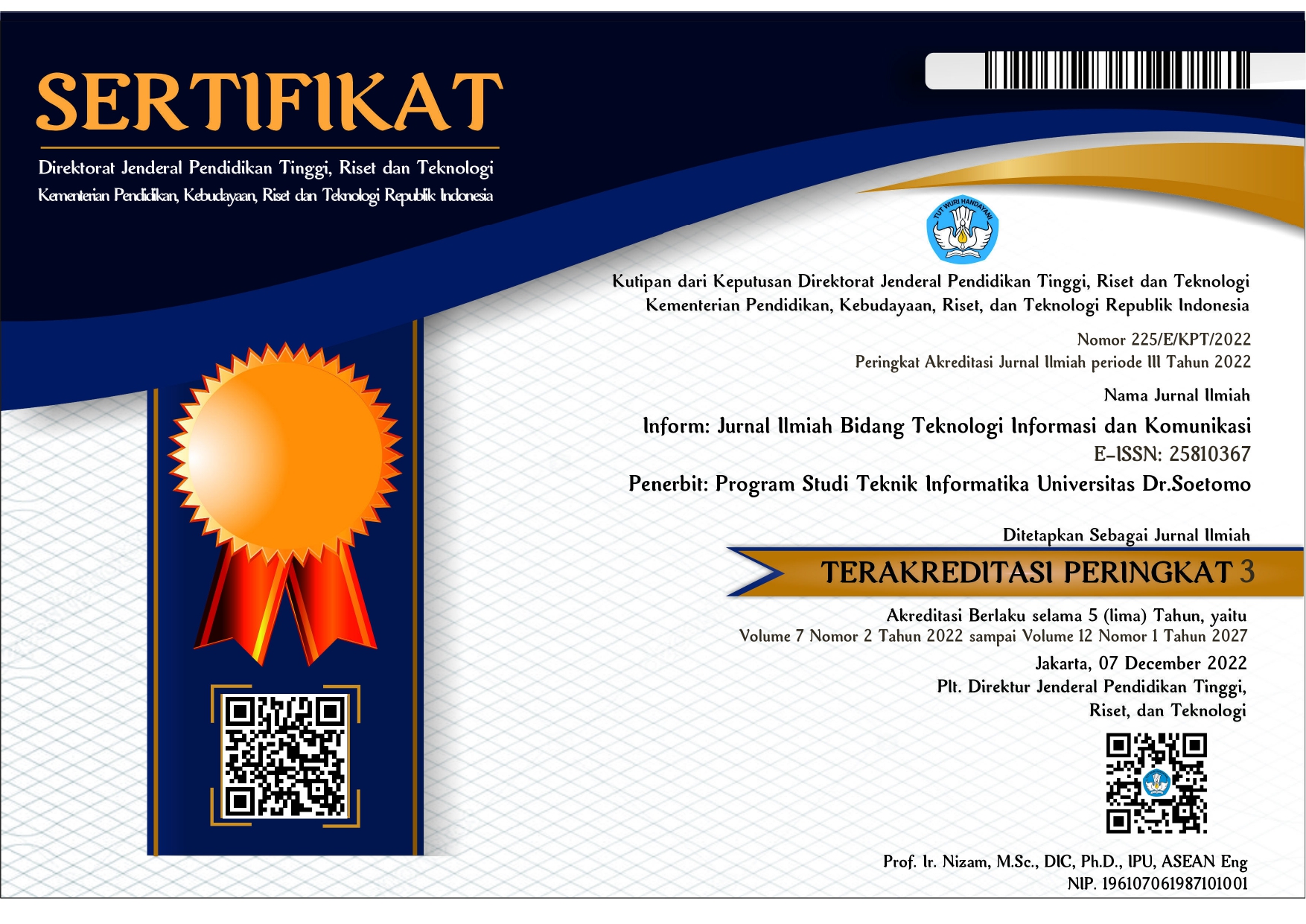Estimation of Brake Pad Wear Using Fuzzy Logic in Real Time
 Abstract views: 310
,
Abstract views: 310
,
 PDF downloads: 258
PDF downloads: 258
Abstract
Brake pad components are important in two-wheeled vehicles because they concern the driver's and others' safety. Brake lining wear is an unavoidable phenomenon. This is because of the concept of braking, which involves bringing two things into contact with each other such that they press against each other and rub against each other. Brake pads that have not been replaced make the brakes unable to work normally, so the potential for accidents is even greater. One of the factors causing the problem is negligence and ignorance of the condition of the ream linings, which should be time for the change. This paper proposes a tool that can estimate the condition of the brake pads based on the level of wear in real-time using the fuzzy logic method. Fuzzy logic will estimate the degree of wear of brake pads based on speed, brake fluid pressure, and braking duration parameters. The type of brake used in this paper is the type of disk brake used on two-wheeled vehicles. The test is not carried out or applied to two-wheeled vehicles but is applied to brake pad wear test equipment that works like a two-wheeled vehicle. Based on the test results, the fuzzy logic implanted into the Arduino microcontroller can provide information on the estimated condition of the brake pads on LCDs in real time based on fuzzy set datasets obtained through experimental tests. Based on the experimental results, the brake lining wear test was carried out for 30 minutes with a pressure of 10 and 17 psi. The results showed that the thickness of the brake linings decreased by around 21.66% and 26.68%, respectively.
References
N. Publikasi, J. Teknik, M. Fakultas, and U. M. Surakarta, “Pengaruh gaya kompaksi pada pembuatan kampas rem dengan resin serbuk sebagai pengikat,” 2014.
A. Keausan et al., “ANALISA KEAUSAN KAMPAS REM PADA DISC BRAKE DENGAN VARIASI KECEPATAN,” Momentum, vol. 13, no. 2, pp. 78–83, 2017.
Kupang.tribunnews.com, “Idealnya Ganti Kampas dan Cairan Rem Setelah Jarak Tempuh Ini,” 2019. .
R. Raja and B. Siregar, “Studi Eksperimental Kedalaman Aus dan Koefisien Gesek Akibat Stick-Slip pada Reciprocating Wear,” vol. 6, no. 2, pp. 268–271, 2017.
R. A. M. Napitupulu, C. S. P. Manurung, and C. Sembiring, “Laju Keausan dan Kekerasan Kampas Rem Pada Sistem Pengereman Sepeda Motor,” vol. 4, no. 1, pp. 10–19, 2022.
A. Intang, “Studi Pengaruh Tekanan Pengereman Dan Kecepatan Putar Roda Terhadap Parameter Pengereman Pada Rem Cakram Dengan Berbasis Variasi Kanvas,” Tek. Mesin Untirta, vol. II, no. JurusanTeknik Mesin. Fakultas Teknik, Universitas Tamansiswa Palembang, pp. 9–19, 2016.
S. Sumiyanto, A. Abdunnaser, and A. N. Fajri, “Analisa Pengujian Gesek, Aus Dan Lentur Pada Kampas Rem Tromol Sepeda Motor,” Bina Tek., vol. 15, no. 1, p. 49, 2019.
P. Tao, Y. Yang, X. Chen, and Y. He, “Effect of Load on Surface Friction and Wear Behavior in ZrCuNiAl Bulk Amorphous Alloy,” Mater. Focus, vol. 4, no. 2, pp. 150–153, 2015.
A. Riyadh, A. Haftirman., and A.-D. Y. Khairel Rafezi., “Effect of Load and Sliding Speed on Wear and Friction of Aluminum– Silicon Casting Alloy,” Int. J. Sci. Res. Publ., vol. 2, no. 3, pp. 3–6, 2012.
M. Ramesh, T. Karthikeyan, R. Arun, and C. Kumaari, “Effects of Applied Pressure on the Wear Behavior of Brake Lining Sliding Against Ferrous and Nonferrous Disc,” Int. J. Adv. Mech. Eng., vol. 4, no. 3, pp. 285–290, 2014.
M. A. Chowdhury and D. M. Nuruzzaman, “Experimental investigation on friction and wear properties of different steel materials,” Tribol. Ind., vol. 35, no. 1, pp. 42–50, 2013.
Y. Wang, X. D. Li, and Z. C. Feng, “The relationship between the product of load and sliding speed with friction temperature and sliding wear of a 52100 steel,” Scr. Metall. Mater., vol. 33, no. 7, pp. 1163–1168, 1995.
A. Gåård, N. Hallbäck, P. Krakhmalev, and J. Bergström, “Temperature effects on adhesive wear in dry sliding contacts,” Wear, vol. 268, no. 7–8, pp. 968–975, 2010.
M. Gailis and D. Berjoza, “On prediction of motor vehicle brake pad wearout,” Eng. Rural Dev., vol. 11, no. January 2012, pp. 349–354, 2012.
C. C. Harlapur, “Brake pad wear detection using machine learning,” Int. J. Adv. Res. Ideas Innov. Technol., vol. 5, no. 2, pp. 498–501, 2019.
A. K. F. Hassan and S. Mohammed, “Artificial Neural Network Model for Estimation of Wear and Temperature in Pin-disc Contact,” Univers. J. Mech. Eng., vol. 4, no. 2, pp. 39–49, 2016.
K. Choudhuri and A. Shekhar, “Predicting Brake Pad Wear Using Machine Learning,” pp. 2–5, 2020.
Copyright (c) 2023 Akhmad Fahruzi; Adam Yuda Wardaya, Andy Suryowinoto

This work is licensed under a Creative Commons Attribution-ShareAlike 4.0 International License.
Authors who publish with Inform: Jurnal Ilmiah Bidang Teknologi Informasi dan Komunikasi agree to the following terms:
-
Authors retain copyright and grant the journal right of first publication with the work simultaneously licensed under a Creative Commons Attribution License (CC BY-SA 4.0) that allows others to share the work with an acknowledgment of the work's authorship and initial publication in this journal.
-
Authors are able to enter into separate, additional contractual arrangements for the non-exclusive distribution of the journal's published version of the work (e.g., post it to an institutional repository or publish it in a book), with an acknowledgment of its initial publication in this journal.
-
Authors are permitted and encouraged to post their work online (e.g., in institutional repositories or on their website) prior to and during the submission process, as it can lead to productive exchanges, as well as earlier and greater citation of published work.











